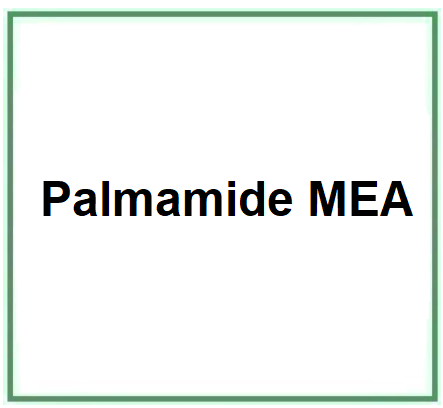Palmamide MEA is a chemical compound, a blend of ethanolamides of the fatty acids by-product of palm oil. Ethanolamides consist of carboxylic acid and amides.
The name describes the structure of the molecule.
- Palmamide indicates that the molecule is derived from palmitic acid, a saturated fatty acid commonly found in palm oil.
- MEA (2-aminoethanol) or Monoethanolamine belongs to the first generation of ethanolamines, is a primary amine and is a strongly alkaline agent, corrosion inhibitor and chemical intermediate.
Function of the Components
Palmamide MEA. It is a conditioning agent used in cosmetics and hair care products. It can help improve the texture and feel of products on the skin or hair.
Raw Materials Used in Production.
- Palm Oil: Extracted from the fruits of the palm plant.
- Monoethanolamine (MEA): An alkaline chemical substance.
Step-by-step Summary of Industrial Production Process.
- Extraction of Palm Oil. The fruits of the palm are extracted to obtain crude palm oil.
- Production of Fatty Acids. The palm oil is hydrolyzed to produce fatty acids.
- Reaction with MEA. The palm-derived fatty acids react with monoethanolamine to produce Palmamide MEA.
- Purification. The Palmamide MEA is purified through methods like distillation or filtration.
Form and Color.
Palmamide MEA appears as a white or slightly yellow waxy solid.

What it is used for and where
Cosmetics
Surfactant - Foam booster. Its function is to introduce gas bubbles into the water for a purely aesthetic factor, which does not affect the cleaning process, but only satisfies the commercial aspect of the detergent by helping to spread the detergent on the hair. This helps in the commercial success of a shampoo formulation. Since sebum has an inhibiting action on the bubble, more foam is produced in the second shampoo.
Viscosity Enhancing Agent - aqueous. Since viscosity is important for increasing the chemical and physical stability of the product, Viscosity Enhancing Agent acqueous is an important dosage factor in gels, suspensions, emulsions, solutions. Increasing viscosity makes formulations less sedimentary and more homogeneously thickened.
Commercial applications
Cosmetic Industry. Used as an emollient, conditioning agent, and antistatic agent in cosmetic products, particularly in hair care products like conditioners and masks.
Origin. Derived from palm oil, a type of vegetable oil commonly used in the cosmetic industry.
Hair Care Products. Helps to make hair soft, smooth, and easily combable, reducing frizziness.
Precautions.
Being derived from palm oil, there are sustainability and deforestation concerns associated with palm oil production.
Safety.
MEA should not be included in products formulated as aerosols and in products containing N-nitroso. Scientific literature agrees that MEA can penetrate and absorb into the skin and cause skin irritation, particularly on the scalp.
![]() Palmamide MEA
Palmamide MEA 


